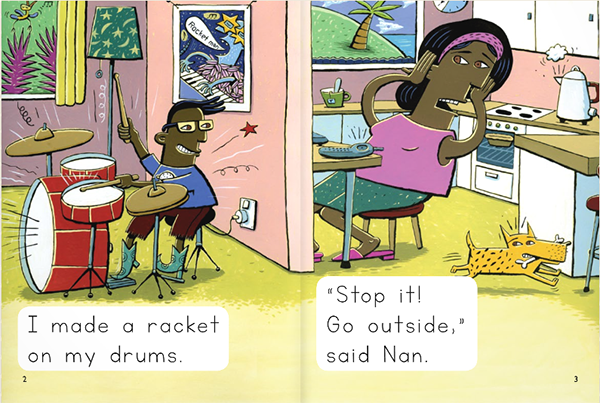Do Children Really Care if Sis Can Hop and Dip?
Flying Start Books Has Found Ways to Balance the Use of Decodable and Leveled Texts.
I recently saw a lesson plan that was shared at a professional learning session for a district’s reading interventionists. After the session presenter told the audience, “Phonics is the answer,” she proceeded to walk them through the lesson plan.
I believe there is a place and a time for using decodable texts; however, they serve one purpose and one purpose only: to help children learn to decode text (this is inherent in their labeling!). They are not meant to motivate children to read, help children comprehend, or even to help children learn vocabulary words. And they certainly are not meant to help children fall in love with reading! Why, then, was the following information included on the lesson plan?:
- Prompt students to find details and support with text evidence
- Offer higher-level question
- Make an inference
- Connect to vocabulary or students’ lives
Consider this decodable text that the same reading interventionists in this district are required to use:
Sis is mad.
The gals hop and dip.
Sis will not hop and dip.
Sis zigs and zags.from Sis, Learning Dynamics Decodable Books
I think you probably get the picture here. Or maybe you don’t?! There’s not much of a story line, and the text is so contrived and unnatural, that I tried reading it aloud to someone and kept making errors! Also, phonics-forward proponents who are equating phonics instruction with the science of reading movement constantly accuse those of us who believe in balanced literacy of encouraging children to look at the pictures and “guess” the words. In the decodable book above, the reader still has to look at the pictures to even get a hint of what is happening in the story (This text is about a girl in a dance class – were you able to gather that from the text?!). While reading this book, the child is forced to only use decoding skills and little to no context. I wonder: What kind of readers are we creating?
The lesson to be learned here is one I always try to convey to my pre- and in-service teachers with whom I work: What is the purpose behind your lesson? And what materials do you need to support that purpose? If the purpose of the lesson is to help students improve their decoding skills while reading continuous text, then a decodable book might be the way to go. If the purpose of the lesson is to help students improve their decoding skills and their understanding of text, then a decodable book may not be the best choice. In the latter case, selecting a text that is labeled a “leveled text” makes much more sense as the primary material for teaching. Using a decodable text just because your district or school tells you to is not a good enough reason to use one. We can, however, find a balance here.
The way Flying Start Books has entered the conversation on balancing the use of leveled and decodable text is remarkable. They have created Red Rocket Reader texts written for the purpose of helping children learn to decode print (e.g., Moon Trip). These texts, however, go along with their popular preexisting leveled texts (e.g., Trip to the Moon, Level H). In this vein, teachers can now use both texts with children to meet decoding- and meaning-based instruction.
Here’s one way I would use these books together during small group instruction:
 Leveled Text: Introduce the text, invite the children to read the text with prompting, discuss the text, and provide a teaching point. If the book is above the group’s instructional reading level, invite the children to engage in a shared reading of the book.
Leveled Text: Introduce the text, invite the children to read the text with prompting, discuss the text, and provide a teaching point. If the book is above the group’s instructional reading level, invite the children to engage in a shared reading of the book.
Decodable Version of the Same Text: Use the same process as above and be sure to emphasize the meaning of the text. Work on a selected phonics skill in isolation for a couple minutes, using tools such as magnetic letters, letter cards, and/or a dry-erase board. Be sure to return to the text to practice the phonics skill in the context of the book. As students decode words in the text, encourage them to confirm their responses by using meaning.
Children deserve authentic and interesting books to read – and young children deserve these types of books to learn how to read. While decodable texts can assist their learning of letters and their sounds, using only decodable texts might stifle their love of reading and create readers who think of reading as just reading the words.
Happy Reading!



